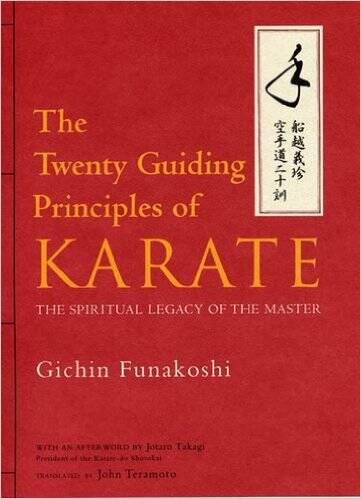HISTORY OF KARATE
The Roots of Karate
Although the popular notion is that Karate was initially developed in Okinawa, its roots are thought to stretch back over 1400 years to Daruma, the founder of Zen Buddhism. Daruma travelled from India to China to teach Buddhism and taught his followers techniques to develop and strengthen mind and body, many of which are basic to modern Karate. His methods were taught in the Shaolin Temple in China, where they eventually developed into the fighting technique known as Shaolin boxing.
Okinawan Influences
Shaolin boxing made its way to Okinawa around the 16th century and was combined with some indigenous Okinawan techniques to form several different fighting styles. During many periods of Okinawan history, the general population were forbidden to own or carry weapons and this resulted in rapid advancement of fighting techniques and the underground development of fighting styles using bare hands or common farming implements. These forms of fighting were known as Okinawa-te or Tode (Chinese Hand) and resulted in the formation of three distinct styles, Shuri-te, Naha-te and Tomari-te (named after the cities where the styles were practiced). The Shorin-ryu style of karate is though to have originated from Shuri and Tomari and Shorei-ryu from the city of Naha. The Shorin-ryu style consisted of fast, linear movements with natural breathing, whilst Shorei-ryu taught strong, rooted techniques with synchronous breathing.
Founding Father of Modern Karate
Gichin Funakoshi was born in 1868 in Okinawa and began to study karate at the age of 11. He studied under many great Okinawan masters of the time and rapidly became adept at both the Shorin and Shorei styles. In fact many of today's modern Shotokan katas have their roots in the original Okinawa-te or Tode katas. Tode could also be pronounced as "kara" and so Tode-te became Kara-te or 'Chinese hand'. Funakoshi adopted the alternate meaning for the Chinese character for 'kara' which is empty and so kara-te came to mean 'empty hand'.
Karate in Japan
Karate was first demonstrated in Japan in 1917 by Gichin Funakoshi at the Butoku-den in Kyoto. He was invited back in 1922 by Dr, Jano Kano, the founder of Judo, and remained in Japan to teach Karate at the Kodokan Dojo with the backing of the Judo master.
Karate gained massive popularity with university students and Funakoshi continued to teach at various colleges around Japan. It is at these colleges and universities that many of the modern masters such as Nakayama, Obata, Noguchi and Watanabe were introduced to the art. By the mid 1930's Gichin Funakoshi started to have less to do with the running of his clubs and handed control to his son Yoshitaka. Yoshitaka continued to modernise the style until in 1936, the Funakoshi's opened a new central dojo - the Shoto-kan (hall of shoto). Shoto was the pen name Gichin Funakoshi used to sign the poems he had written in his youth. World War II had a serious effect on the growth of Karate in Japan, as many of the former practitioners went off to serve in Japan's armed forces. The additional blows of the death of Yoshitaka, the destruction of the Shoto-kan and the banning of Martial Arts by the conquering Allied forces, left Shotokan Karate in complete disarray.
Gichin Funakoshi and Shotokan Karate
Gichin Funakoshi managed to get the ban on Karate lifted and in 1948 the Nihon Karate Kyokai (Japan Karate Association) was formed, with Master Funakoshi named as chief instructor. Due to Funakoshi's advancing age (81), Masatoshi Nakayama took on most the teaching and Hidetaka Nishiyama headed up the instruction committee. Master Funakoshi died in April of 1957.
Engraved on his memorial in Kita Kamakura, Japan are the words "Karate ni sente nashi" or "There is no first attack in Karate". After his death, Funakoshi's students adopted "Shotokan" as the name of the style of karate they practiced and today Shotokan is one of the most popular martial styles in the world.

Karate-Do

Gichin Funakoshi 1868-1957

Master Funakoshi studied Zen here on the grounds of Engakuji Temple under Chief Abbott Ekun and completed his training around 1929. It was then that he changed the name of his Okinawan art from "Tode" (Chinese Hand ) to
"Karate-Do" (Empty Handed Way).

The memorial to Master Gichin Funakoshi - located on the grounds of Engakuji Temple, in Kamakura, Japan.

Shotokan
The Dojo Kun and Shoto Niju Kun
Founder of Shotokan Karate, Gichin Funakoshi, taught karate continuously for close to half a century. For him, karate was a way on life - karate -“do’. “Do” means “way” or “life path”. During his many years instructing he assembled two well-known lists of karate training principles called “The Dojo Kun” and “Shoto Niju Kun”.
WSKF SEDAI adopts and observes these as guiding principles to our teaching, training and conduct
Dojo Kun
Seek Perfection of Character
Hitotsu! Jinkaku kansei ni tutomuru koto.
(To strive for the perfection of character)
Be Faithful
Hitotsu! Makato no michi wo mamoru koto.
(To protect/defend the paths of truth)
Endeavor to Excel
Hitotsu! Doryoku no seishin wo yashinau koto.
(To foster the spirit of effort)
Respect Others
Hitotsu! Reigi wo omonjiru koto.
(To honor the principles of etiquette)
Refrain from violent behavior
Hitotsu, kekki no yū wo imashimeru koto
(Guard against impetuous courage)


Gichin Funakoshi - The Founder of Modern Karate
Refrain from Violent Behaviour
Hitotsu! Kekki no yu o imashimuru koto.
(To Guard Against Impetuous Courage.)
Niju Kun
Karate-do begins and ends with bowing
Hitotsu, karate-do wa rei ni hajimari rei ni owaru koto o wasuruna
*
There is no first strike in karate.
Hitotsu, karate ni sente nashi
*
Karate stands on the side of justice.
Hitotsu, karate wa, gi no tasuke
*
First know yourself, then know others.
Hitotsu, mazu onore o shire, shikashite ta o shire
*
Mentality over technique.
Hitotsu, gijutsu yori shinjutsu
*
The heart must be set free.
Hitotsu, kokoro wa hanatan koto o yosu
*
Calamity springs from carelessness.
Hitotsu, wazawai wa ketai ni seizu
*
Karate goes beyond the dojo
Hitotsu, dojo nomino karate to omou na
*
Karate is a lifelong pursuit.
Hitotsu, karate no shugyo wa issho de aru
*
Apply the way of karate to all things. Therein lies its beauty.
Hitotsu, ara yuru mono o karateka seyo; soko ni myomi ari
*
Karate is like boiling water; without heat, it returns to its tepid state.
Hitotsu, karate wa yu no gotoshi taezu netsu o ataezareba moto no mizu ni kaeru
*
Do not think of winning. Think, rather, of not losing.
Hitotsu, katsu kangae wa motsuna; makenu kangae wa hitsuyo
*
Make adjustments according to your opponent.
Hitotsu, tekki ni yotte tenka seyo
*
The outcome of a battle depends on how one handles emptiness and fullness (weakness and strength).
Hitotsu, tatakai wa kyojitsu no soju ikan ni ari
*
Think of hands and feet as swords.
Hitotsu, hito no teashi o ken to omoe
*
When you step beyond your own gate, you face a million enemies.
Hitotsu, danshimon o izureba hyakuman no teki ari
*
Format stances are for beginners; later, one stands naturally.
Hitotsu, kamae wa shoshinsha ni ato wa shizentai
*
Perform prescribed sets of techniques exactly; actual combat is another matter.
Hitotsu, kata wa tadashiku, jisen wa betsumono
*
Do not forget the employment of withdrawal of power, the extension or contraction of the body, the swift or leisurely application of technique.
Hitotsu, chikara no kyojakutai no shinshuku waza no kankyu o wasuruna
*
Be constantly mindful, diligent, and resourceful, in your pursuit of the Way.
Hitotsu, tsune ni shinen kufu seyo
